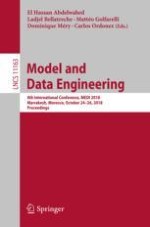2018 | Book
Model and Data Engineering
8th International Conference, MEDI 2018, Marrakesh, Morocco, October 24–26, 2018, Proceedings
Editors: El Hassan Abdelwahed, Ladjel Bellatreche, Mattéo Golfarelli, Dominique Méry, Carlos Ordonez
Publisher: Springer International Publishing
Book Series : Lecture Notes in Computer Science
